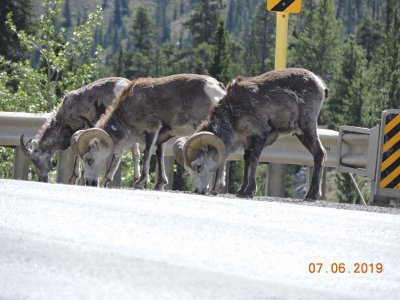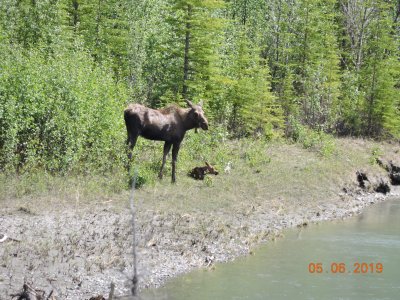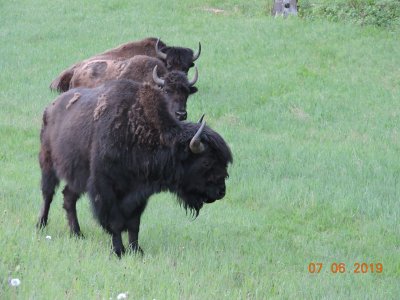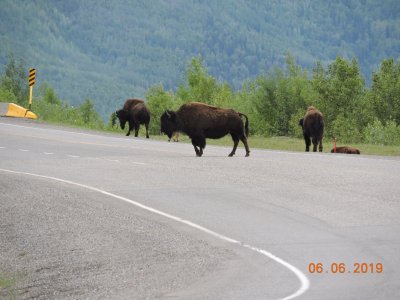| North in the Spring #10 Crossing the Northern Rockies: on the Alaska Highway by John Neville (photos by Heather Neville)  North of Fort Nelson, we left a broad U-shaped valley behind and ascended the Rocky Mountain foothills. At km 536 it was snowing lightly. We stopped at a viewing platform and our only company was a Varied Thrush. We were on the edge of the Muskwa-Kechika Management Area. A notice board told us that:
North of Fort Nelson, we left a broad U-shaped valley behind and ascended the Rocky Mountain foothills. At km 536 it was snowing lightly. We stopped at a viewing platform and our only company was a Varied Thrush. We were on the edge of the Muskwa-Kechika Management Area. A notice board told us that:
At four and a half million hectares it is about the size of Ireland! It is a complete ecosystem supporting a predator-prey interaction only matched in Africa's Serengeti. It reaches west to the Spatsizi Plateau and from the Yukon Border south to Williston Lake. The area was set aside by the Provincial government in 1997 to protect the environment, needs of society, and our economy. The highway followed the Tetsa River Valley up to Stone Mountain Provincial Park and Summit Lake. Then we started to descend into a canyon where we found Stone Sheep, a thin horned subspecies of Dall Sheep. The rams have curly horns and the ewes have shorter, straighter horns. The horns continue to grow throughout their lives. They stand about 1 meter tall and are a brownish colour. There were two rams and two ewes down on the road, grazing and licking salt. Up above there were four more rams, leisurely watching the action below! 
We followed the Race River down the western side emerging onto open aspen parkland and the small community of Toad River. Our next stop was at Muncho Lake Provincial Park to photograph a moose with her calf. The very young calf was sleeping by the water while mum grazed. The male is larger and weighs up to 530 kg. Their massive antlers are palmate with small prongs. They are the largest member of the deer family. Moose have a peculiar bell-shaped pendent on their throat. In the Algonquin language Moose means "twig eater". They can swim as fast as two men can paddle a canoe and their top running speed is 56 kph! On an alluvial fan called Strawberry flats we camped for the night. Muncho means "big lake" in the Kaska Dene language. The lake is surrounded by imperious mountain peaks. The surface elevation of the lake is 817 m. and the length is 12 km. The fine rock particles suspended in the water having been ground down to flour by the glaciers. The rock flour reflects and scatters sunlight in the blue-green part of the light spectrum. We were in the northern most section of the Rocky Mountains. The Terminal Range ends at the Liard River 60 km to the northwest. The following morning we walked along the shore I heard Spotted Sandpiper and Mew Gull hidden somewhere in the mist. 
Thrust up from an ancient ocean bed the mountains have been carved by glaciers, water, weather and time. The road north descended through forest to the Trout and Liard River valleys. Above avalanche runs dotted the landscape. Then large droppings alerted us to the Buffalo ahead! We counted 35 animals but there may have been more in the trees. There were 6 young ones sleeping in the middle protected by cows and bulls. The open green grass on the verge of the road is a very important part of their diet. We also saw a Porcupine run along with his distinctive, swaying gait. I was close enough to hear the shake, rattle and roll of the quills as it ran towards a culvert. Our next stop was an oasis called the Liard Hot Springs. The water in the pools can be a cool 36 and up to a hot 52 *C. The water wells up through the limestone containing minerals up to a thousand parts per million. The commonest mineral is calcium carbonate. The pools are surrounded Ostrich Ferns and Cow-parsnip. Needless to say, we luxuriated in the water and fresh air! The water runs into a marsh. To reach the pools you take a 5 minute walk along a boardwalk which cross's the marsh. In the surrounding area are Black Spruce, but within the influence of the warm water there is a marked change in the vegetation. For example there are 14 different orchids. Chara or stoneworts is an ancient algae which absorbs calcium carbonate to form hard cell walls, giving it a crunchy texture. The Chara form into clumps just under the surface and eventually create lumpy, bumpy rocks called Tufts. The Hot Water Physa is a tiny snail. This is the only place on earth where these snails are found. Physa lay 6 to 18 eggs which hatch in a few days. They live for about 1 year. Walking along the boardwalk we noticed minnows swimming below us, which turned out to be Lake Chub. A Canada goose was sitting on her nest as we passed. A young moose used her 1 to 2 m. stride to step effortlessly up and over the boardwalk. Like everyone else leaving the Hot Springs we felt refreshed.  
|